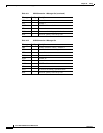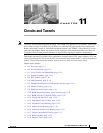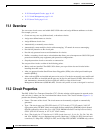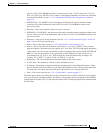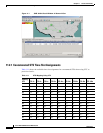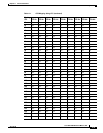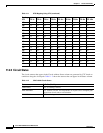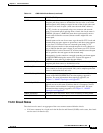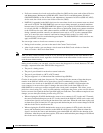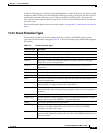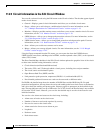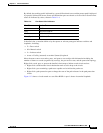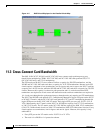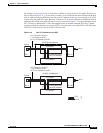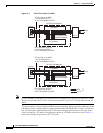
11-8
Cisco ONS 15454 Reference Manual, R7.0
78-17191-01
Chapter 11 Circuits and Tunnels
11.2 11.2.3 Circuit States
• If all cross-connects in a circuit are in an Out-of-Service (OOS) service state, such as Out-of-Service
and Management, Maintenance (OOS-MA,MT); Out-of-Service and Management, Disabled
(OOS-MA,DSBLD); or Out-of-Service and Autonomous, Automatic In-Service (OOS-AU,AINS)
service state, the circuit service state is Out-of-Service (OOS).
• PARTIAL is appended to the OOS circuit service state when circuit cross-connects state are mixed
and not all in IS-NR. The OOS-PARTIAL state can occur during automatic or manual transitions
between states. For example, OOS-PARTIAL appears if you assign the IS,AINS administrative state
to a circuit with DS-1 or DS3XM cards as the source or destination. Some cross-connects transition
to the IS-NR service state, while others transition to OOS-AU,AINS. OOS-PARTIAL can appear
during a manual transition caused by an abnormal event such as a CTC crash or communication
error, or if one of the cross-connects could not be changed. Refer to the Cisco ONS 15454
Troubleshooting Guide for troubleshooting procedures. The OOS-PARTIAL circuit state does not
apply to OCHNC circuit types.
You can assign a state to circuit cross-connects at two points:
• During circuit creation, you can set the state in the Create Circuit wizard.
• After circuit creation, you can change a circuit state in the Edit Circuit window or from the
Tools > Circuits > Set Circuit State menu.
Note After you have created an initial circuit in a CTC session, the subsequent circuit states default to the
circuit state of the initial circuit, regardless of which nodes in the network the circuits traverse or the
node.ckt.state default setting.
During circuit creation, you can apply a service state to the drop ports in a circuit; however, CTC does
not apply a requested state other than IS-NR to drop ports if:
• The port is a timing source.
• The port is provisioned for orderwire or tunnel orderwire.
• The port is provisioned as a DCC or DCC tunnel.
• The port supports 1+1 or bidirectional line switched rings (BLSRs).
Circuits do not use the soak timer, but ports do. The soak period is the amount of time that the port
remains in the OOS-AU,AINS service state after a signal is continuously received. When the
cross-connects in a circuit are in the OOS-AU,AINS service state, the ONS 15454 monitors the
cross-connects for an error-free signal. It changes the state of the circuit from OOS to IS or to
OOS-PARTIAL as each cross-connect assigned to the circuit path is completed. This allows you to
provision a circuit using TL1, verify its path continuity, and prepare the port to go into service when it
receives an error-free signal for the time specified in the port soak timer. Two common examples of state
changes you see when provisioning circuits using CTC are:
• When assigning the IS,AINS administrative state to cross-connects in VT circuits and VT tunnels,
the source and destination ports on the VT circuits remain in the OOS-AU,AINS service state until
an alarm-free signal is received for the duration of the soak timer. When the soak timer expires and
an alarm-free signal is found, the VT source port and destination port service states change to IS-NR
and the circuit service state becomes IS.
• When assigning the IS,AINS administrative state to cross-connects in STS circuits, the circuit
source and destination ports transition to the OOS-AU,AINS service state. When an alarm-free
signal is received, the source and destination ports remain OOS-AU,AINS for the duration of the
soak timer. After the port soak timer expires, STS source and destination ports change to IS-NR and
the circuit service state changes to IS.



